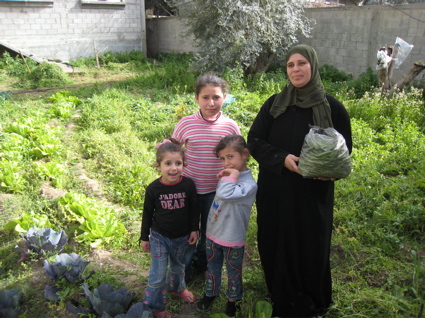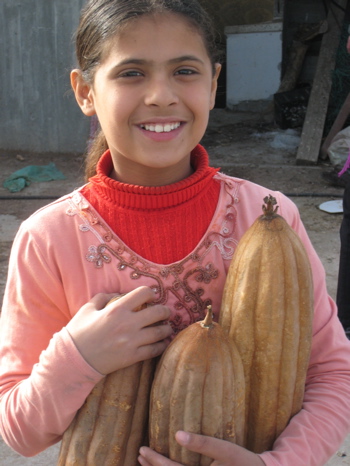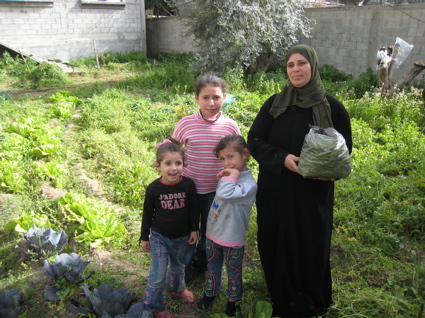 Gaza gardeners, with harvest.Photo: Grassroots InternationalThis is the time of year when gardeners start to reap their rewards–fruits and vegetables that make for a healthy feast. But for the people of Gaza, gardens produce a serving of self-sufficiency, too.
Gaza gardeners, with harvest.Photo: Grassroots InternationalThis is the time of year when gardeners start to reap their rewards–fruits and vegetables that make for a healthy feast. But for the people of Gaza, gardens produce a serving of self-sufficiency, too.
Urban gardens usually bring to mind savvy urbanites indulging in an organic lifestyle–witness Michelle Obama and her model urban garden at the White House. Although urban gardens in the West may not be a total indulgence–Ms. Obama, for example, is trying to counteract the growing instances of diabetes and obesity–they are hardly a necessity.
In the Gaza Strip, on the other hand, where more than 80 percent of residents are dependent on food aid, urban gardens mean survival, and resistance to Israel’s policies of occupation and blockade. When only half of the U.N.’s food aid is actually allowed in to Gaza (during the last siege on Gaza, only 10% of the food trucks were allowed entry), planting an edible garden on just a scrap of land can be enough to ensure self-sufficiency. In an enormously insecure and unstable zone, a simple urban garden ensures food security, and food sovereignty.
The World Food Programme says “Gazans face an acute shortage of nutritious, locally-produced and affordable food.” The drastically reduced consumption of meat, oils, fats, fruits and dairy products can lead to anemia and stunted growth. Fifteen percent of Palestinian schoolchildren are “intellectually impaired” due to malnutrition, according to the Gaza Community Mental Health Program. Since last December, the price of pepper has doubled, the price of onions increased 33% and chicken 43%.
Urban gardens are just now gaining popularity in the West, thanks to the rise of environmentalism and health awareness (Ms. Obama only planted hers in April). But Grassroots International, a Boston-based nonprofit has been funding efforts to plant urban gardens in the Gaza Strip for the last five years.
 Photo: Grassroots InternationalGrassroots partners with the Palestinian Agricultural Relief Committees (PARC), a progressive organization that runs an “Urban Gardens” initiative. To date, PARC has set up 1,000 urban gardens in Gaza. Last year, Grassroots granted $25,000 to PARC’s “Urban Agriculture for Food Security and Increased Income Project.” PARC also runs a Farm-to-Table program sourcing local food from Gazan farmers for Gazans in need of food aid – a model worth emulating globally.
Photo: Grassroots InternationalGrassroots partners with the Palestinian Agricultural Relief Committees (PARC), a progressive organization that runs an “Urban Gardens” initiative. To date, PARC has set up 1,000 urban gardens in Gaza. Last year, Grassroots granted $25,000 to PARC’s “Urban Agriculture for Food Security and Increased Income Project.” PARC also runs a Farm-to-Table program sourcing local food from Gazan farmers for Gazans in need of food aid – a model worth emulating globally.
Ahmed Sourani, is PARC’s project director in Gaza City (PARC works in the West Bank as well). He says that urban gardens are vital not just for food security but as a way to empower women, and a way to “revitalize” agriculture in general. Household gardens are a part of Gazan culture, he explains, and says, “Since women are the primary caretakers of these gardens, the status of women will advance as this vital food source expands in the community.”
PARC provides women with vegetable and fruit seeds, and gives them rigorous training in how to maintain a garden: they learn about composting, fencing, irrigation, and how to make and use natural “green” pesticides. Women learn how to turn any scrap of land-even on a rooftop-into a blossoming garden.
Women are also taught how to raise rabbits, which are notoriously easy to breed. PARC incorporates animal husbandry into its training because, explains Sourani, chicken and other sources of protein are so prohibitively expensive. Between the gardening and the animal husbandry, a number of households can become almost completely self-sufficient.
Um Abdullah, who lives in the bleak al-Maghazzi district, is just one example: she grows corn, spinach, cabbage, eggplant, beans, peas, zucchini…even alfalfa for her rabbits. And in fact, PARC has helped Um Abdullah raise not just rabbits, but pigeons, chicken and ducks. They’ve helped her grow trees like orange, lemon, peach, palm, and pear. Her urban garden provides more than food security for her family, it provides financial security; it’s her livelihood.
 War can make gardening necessary–and simultaneously impossible. Photo: Grassroots InternationalDespite the success, the urban gardens of Gaza are at risk. Half of the gardens funded by Grassroots International were destroyed in Israel’s December ’08-January ’09 assault. Most of the rabbits were killed by plumes of white phosphorous unleashed by the Israeli military. Human Rights Watch has confirmed the use of white phosphorous, stating, “A disturbing weapon was used against Gazan civilians and their livestock by the Israeli military in violation of international law.”
War can make gardening necessary–and simultaneously impossible. Photo: Grassroots InternationalDespite the success, the urban gardens of Gaza are at risk. Half of the gardens funded by Grassroots International were destroyed in Israel’s December ’08-January ’09 assault. Most of the rabbits were killed by plumes of white phosphorous unleashed by the Israeli military. Human Rights Watch has confirmed the use of white phosphorous, stating, “A disturbing weapon was used against Gazan civilians and their livestock by the Israeli military in violation of international law.”
Grassroots released emergency funding, but it’s not just the gardens that are struggling. PARC too suffered a great set-back. Its office was occupied by soldiers and severely damaged. Their greenhouse training facility was lost, as were most documents and twenty computers.
Right after the war, Salena Tramel, Grassroots’ Program Coordinator for the Middle East & Haiti saw first-hand both the destruction and resilience in Gaza. She recounts the story of an old man who lived next to PARC’s office. The day after Israeli Defense Forces destroyed PARC’s model urban garden, he took his sons to start replanting it. “This is how I can teach them to not lose hope,” he said.
Grassroots and PARC are trying to rebuild Gaza’s gardens, resolute to make them a permanent fixture and a symbol of justice and hope for Palestinian human rights and self-determination. The White House lawn, let’s remember, isn’t the only place for an urban garden.



